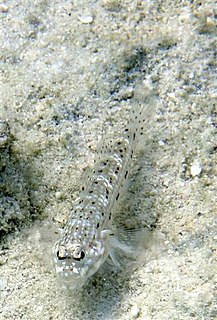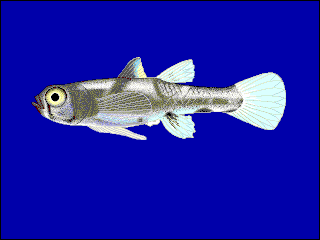
Favonigobius is a genus of gobies native to fresh, brackish and marine waters around the Indian Ocean and the western Pacific Ocean. Commonly called "sand gobies", this term more alternatively refers to the family Kraemeriidae, a relative of the true gobies.

Exyrias is a genus of gobies mostly native to marine waters of the Indian Ocean and the western Pacific Ocean with one freshwater species (E. volcanus) known from the Philippines.

Fusigobius is a genus of coral reef inhabiting gobies found throughout the Indian and western Pacific Oceans.

Redigobius is a genus of fish in the goby family, Gobiidae, known commonly as dualspot gobies. They are native to the western Indo-Pacific region, where they occur in estuaries and freshwater habitats just above the tidal influence.
Silhouettea is a genus of gobies native to the Indian Ocean and the western Pacific Ocean. The name of this genus refers to the island of Silhouette in the Seychelles where the type specimens of the type species, Silhouettea insinuans, were collected.
Taenioides is a genus of gobies native to fresh, brackish, and marine waters of the coastal areas of the Indian Ocean and the western Pacific Ocean.

The Gobiiformes are an order of fish that includes the gobies and their relatives. The order, which was previously considered a suborder of Perciformes, is made up of about 2,211 species that are divided between seven families. Phylogenetic relationships of the Gobiiformes have been elucidated using molecular data. Gobiiforms are primarily small species that live in marine water, but roughly 10% of these species inhabit fresh water. This order is composed chiefly of benthic or burrowing species; like many other benthic fishes, most gobiiforms do not have a gas bladder or any other means of controlling their buoyancy in water, so they must spend most of their time on or near the bottom. Gobiiformes means "Goby-like".

Koumansetta is a small genus of gobies native to the Indian Ocean and the western Pacific Ocean. The name of this genus honours the Dutch ichthyologist and goby taxonomist Frederik Petrus Koumans (1905-1977) of the Rijksmuseum van Natuurlijke Historie in Leiden, Netherlands, who had written a description of Koumansetta rainfordi following a visit to the Australian Museum in Sydney in 1938 but did not name it. The outbreak of World War II meant that Whitley's correspondence with Koumans was interrupted, so he named this genus after him, noting “which will enshrine memories of happier days of our meetings in Leiden and Sydney”.
Arenigobius is a genus of gobies native to the Indian Ocean and the western Pacific Ocean.

The small-eyed goby is a species of goby native to tropical reefs of the Indian Ocean through the western Pacific Ocean where it inhabits areas of coral rubble. As its common name suggests, this species has particularly small eyes. This species grows to a length of 6 centimetres (2.4 in) TL. This species is the only known member of its genus. The small-eyed goby is specialised to feed on seagrass and they share a burrows with mud lobsters of the genus Thalassina. The specific name honours Charles Melbourne Ward (1903-1966), the Australian actor, naturalist and collector of specimens who collected the type specimen.

Cabillus is a genus of gobies native to the Indian and Pacific oceans.

Callogobius is a genus of fish in the family Gobiidae found in brackish and marine waters of the Indian and Pacific Ocean.
Chaeturichthys is a genus of gobies native to the western Pacific Ocean.
Coryphopterus is a genus of gobies mostly found in the western Atlantic Ocean though a couple species are found in the Indian and/or Pacific oceans.
Discordipinna is a genus of gobies native to the Indian Ocean and the western Pacific Ocean.
Feia is a genus of gobies native to shallow coastal waters of the Indian Ocean and the western Pacific Ocean.
Palutrus is a genus of gobies native to the Indian Ocean and the western Pacific Ocean.

Pandaka is a genus of fish in the goby subfamily, Gobionellinae, native to fresh, brackish and marine waters of Asia and the western Pacific Ocean. Some species in the genus are among the smallest fish in the world; the male P. pygmaea can be just 9 mm (0.35 in) in standard length at maturity.
Psilotris is a genus of gobies native to the western Atlantic Ocean.

Varicus is a genus of fish in the family Gobiidae, the gobies. They are native to the western Atlantic Ocean.











